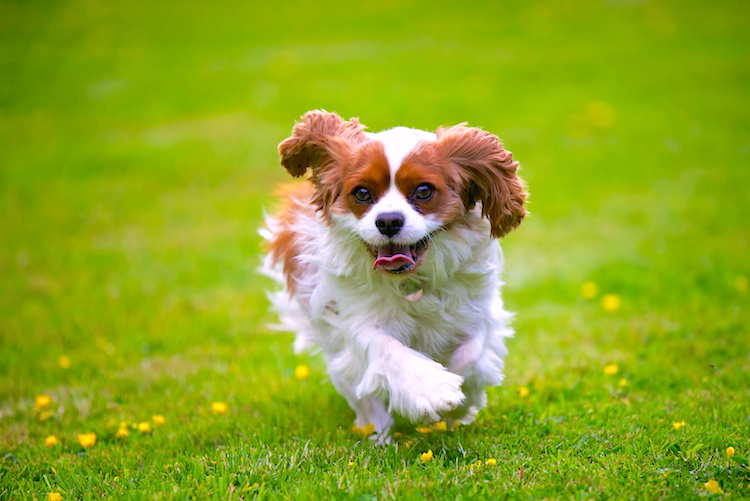
Does your dog have a hidden risk of pneumonia — but you don’t know it?
Previously, we have written about the risks of feeding a dog ahead of having a general anesthetic. One of very real dangers is that the dog vomits and inhales stomach acid down into the lungs, causing a form of pneumonia.
My caseload this week included a little dog with just such an aspiration pneumonia … but for a different reason.
Aspiration Pneumonia in Dogs
Aspiration pneumonia can happen to any dog if they eat or drink in a certain way.
This little dog, Phoebe, hadn’t had an anesthetic but did have breathing and swallowing difficulties. This combination meant she had accidentally inhaled food while eating, which had resulted in a case of aspiration pneumonia.
So why would a dog be so clumsy as to inhale their food? Well, Phoebe hadn’t done this deliberately, but her anatomy was against her.
Phoebe is a Pekingese and has the typical flat face associated with the breed. Her narrow nostrils, outsized tongue and large tonsils meant she always pants heavily.
Unfortunately, the larynx — the structure designed to protect the entrance to her airway — wasn’t working properly. This made for a bad combination of circumstances that ended with serious pneumonia.
Phoebe must have been unlucky enough to inhale sharply at the same time as taking a mouthful of food. Sadly, her larynx didn’t properly protect the airway. The resulting suction, in a sort of siphon effect, had sucked food down into her lungs.
Phoebe’s symptoms included a cough, which got worse when she moved around. Even with moderate exercise, such as walking across the room, her lungs were unable to meet demand for extra air and she had to rest.
The chest infection also made her feel unwell, and so her appetite dropped off.
In short, Phoebe lost her mojo, stopped eating, lost weight and had an unpleasant hacking cough.
At this point, she was brought in to be checked out.

The Risk Factors for Aspiration Pneumonia in Dogs
Veterinarians see relatively few cases of aspiration pneumonia in dogs, but arguably this condition should be more common.
There are several factors that can put a dog at increased risk of inhaling or aspirating food down into the lungs.
Risk factors include:
- Laryngeal paralysis
- Swallowing difficulties
- Megaosephagus
- Greedy eaters
Laryngeal Paralysis
The larynx is the structure at the top of the airway that should close when the dog swallows.
Was YOUR Pet Food Recalled?
Check Now: Blue Buffalo • Science Diet • Purina • Wellness • 4health • Canine Carry Outs • Friskies • Taste of the Wild • See 200+ more brands…

If the nerve to the larynx is damaged, then the larynx becomes paralyzed and no longer works properly.
The laryngeal nerve can become damaged by innocuous things, such as a dog pulling hard on a collar or being jerked harshly on the neck. (This is a good argument for wearing a harness rather than a collar.)
However, laryngeal paralysis is overrepresented in some breeds and seems to have a genetic cause rather than trauma.
Breeds most at risk include:
- Labrador Retrievers
- Golden Retrievers
- Great Danes
- Setters
- Afghans
- Saint Bernards
Swallowing Difficulties
This is where flat-faced breeds come in.
On a hot day or if the dog has exercised, they may pant heavily. While panting, they might even inhale their own saliva or, if they eat and continue to pant, might suck food down into the lungs.
Megaesophagus
This condition is where the esophagus (the tube joining the mouth to the stomach, also known as the gullet) doesn’t work properly. Instead of being a tight muscular hose pushing food downward, the esophagus becomes big and baggy.
Food collects in the gullet, and when the dog lowers their head, the food falls back into the mouth. If the dog happens to breathe in at the same time, they can inhale it down into the lungs.
Many dogs who develop megaesophagus do so for no identifiable reason. However, in others, it is linked to conditions such myasthenia gravis or underactive thyroid glands.
Greedy Eaters
Says it all, really!
If your dog inhales food instead of chewing it, there’s a potential risk they will suck food into the lungs.
These dogs need slowing down (not least because it increases the risk of bloat) with slow feeders or the like.

Diagnosing Aspiration Pneumonia in Dogs
Any investigation by a vet must be done with care because these animals are usually weak.
Listening to the chest with a stethoscope, the vet hears a variety of unusual lungs sounds, including crackles and pops. One of the most useful diagnostic tests to confirm the suspicion is to X-ray the chest to look at patterns within the lungs.
If the dog is breathing heavily, a conscious chest X-ray gives useful information about the pattern within the lungs, which can suggest aspiration pneumonia:
- Your vet will handle the dog as gently as possible so as not to further distress their breathing.
- On X-ray, aspiration pneumonia can have a pattern in the lower parts of the lungs where the aspirated food or fluid settles under gravity.
Blood tests can identify signs associated with inflammation or infection.
If the dog is strong enough, then a procedure called bronchoalveolar lavage can provide a sample of cells for culture to pinpoint which antibiotic will kill the infection:
- This involves putting a narrowing tube down the patient’s windpipe, flushing with saline and then sucking the sample back up.
- Not all animals will be well enough for this, so your vet may start broad spectrum antibiosis anyway.

Treating Aspiration Pneumonia in Dogs
Antibiotics are necessary to get to grips with the bacteria causing the infection.
Time is of the essence:
- The swifter infection is brought under control, the better the likely outcome.
- Thus, antibiotics should be started before lab results come back.
However, aspiration pneumonia is a potentially serious condition and one that’s best avoided altogether. It can be difficult to treat, and not all dogs respond to treatment.
Sadly, those who do the least well are those who inhale stomach acid. The double whammy of food and acid can be a deadly combination.
As well as medical treatment, physiotherapy exercises, such as coupage of the chest, can help. This involves gently tapping the chest with cupped hands, which breaks down trapped secretions and allows the dog to cough it up.
A dog with aspiration pneumonia has difficulty breathing, so bed rest — and possibly even an oxygen tent — can help.
Don’t let your dog lie in one position for hours on end. This allows fluid to dangerously pool in the lower lung. A sick dog having difficulty breathing should be rolled onto the opposite side every 2 hours.
Here’s a little more on aspiration pneumonia in dogs:
Preventing Aspiration Pneumonia in Dogs
So, how can you reduce your dog’s risk of developing aspiration pneumonia?
- Slow up their eating using puzzle or slow feeders.
- Manage megaesophagus by using a Bailey Chair or feeding from a height.
- Don’t over exert flat-faced breeds in the heat.
- Starve ahead of an anesthetic.
Remember, aspiration pneumonia in dogs is best prevented in the first place, so be aware of the hidden risks.
If your dog has a pre-existing condition, such as megaesophagus, that makes it difficult to swallow, then feeding them with their forequarters raised above head height gets gravity to help the food go down.
While syringe feeding, press the plunger slowly, making sure your pet swallows fully each time. Any animal that develops labored breathing should be taken to a vet for an urgent examination.
Reference
- Broe, P.J. et al. “Aspiration Pneumonia: Treatment With Pulmonary Vasodilators.” Surgery 94, no. 1. (July 1983): 95–99. https://www.ncbi.nlm.nih.gov/pubmed/6857518.
 This pet health content was written by a veterinarian, Dr. Pippa Elliott, BVMS, MRCVS. It was last reviewed Dec. 23, 2018.
This pet health content was written by a veterinarian, Dr. Pippa Elliott, BVMS, MRCVS. It was last reviewed Dec. 23, 2018. 


